The fusion method and the pressed powder method are well-known and typical sample preparation techniques in X-ray fluorescence analysis of powder samples. In the fusion method, a sample is fused with some alkali borate flux at high temperature to make a glass bead. The method allows more accurate analysis because it provides a substantially homogeneous sample specimen for analysis. It is, however, a costly and time-consuming technique. For highly precise analysis, a fusion machine is essential for making fused beads under identical conditions.
In the pressed powder method, a briquette is formed by pressing a ground powder sample with a ring or cup using a pressing machine. The pressed powder method is a very simple technique that requires no skills or experience. Therefore, this method is suited for rapid analysis or analysis of large quantities of sample. The pressed powder method, however, can create some errors due to grain size and mineralogical heterogeneity effects during sample measurement. It is nearly impossible to eliminate these heterogeneity effects in all powder samples, especially with materials such as soils, rocks, ores, etc., which are composed of different types of grains. Therefore, large differences can occur between analysis results and the actual chemical content.
Both the fusion method and the pressed powder method have advantages and disadvantages as described above. Generally, the optimal sample preparation method for each material is determined by considering requirements such as precision, cost, preparation time, etc. This report provides a comparison between analysis results using the fusion method and the pressed powder method applied to three materials: iron ores, silicate rocks and cements. In the industrial and research fields, the X-ray fluorescence technique is commonly used to control manufacturing processes, to monitor product quality and to determine geochemical characterization. In these three material fields, either the fusion method or the pressed powder method is selected in accordance with the purpose of analysis.
In this report, calibration curves for major components are prepared by both sample preparation methods, and analyses of identical samples with chemical values are performed by each method. The standard error of the estimate as accuracy obtained by the differences between chemical values and analyzed values of calibration standards is calculated and compared between the two methods

